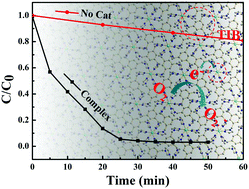A novel nitrogen heterocyclic ligand-based MOF: synthesis, characterization and photocatalytic properties†
Abstract
A coordination polymer, {[Co(tib)2]·SO4}n, has been synthesized by a solvothermal reaction using the flexible tripodal ligand 1,3,5-tris(imidazol-1-ylmethyl)benzene (TIB) with metal salts, and has been characterized by Fourier-transform infrared spectroscopy (FTIR), X-ray diffraction (XRD), X-ray photoelectron spectroscopy (XPS), thermogravimetric analysis (TGA) and UV-vis diffuse reflectance spectroscopy. The photocatalytic properties of the complex were investigated by the photodegradation of methylene blue (MB) dye under visible light. Control experiments clearly revealed that the pH of the solution plays an important role in MB degradation, especially when in alkaline solution. {[Co(tib)2]·SO4}n has excellent degradation ability of MB, and 150 mL MB (10 mg L−1) could be fully photodegraded in 25 min with a high pseudo-first-order rate constant. The reaction mechanism of photocatalysis showed that O2˙− and h+ are the main active substances, based on active species trapping experiments and ESR. The excellent photocatalytic activity is mainly attributed to the strong light harvesting and high reactivity of electrons and holes. Moreover, liquid chromatography-mass spectrometry (LC-MS) was used to analyze the catalytic process, effectively revealing the photodegradation mechanism of MB. Recycling experiments demonstrated that the photocatalyst is reusable and stable. This MOF-based photocatalyst will, therefore, provide new efforts towards environmental purification.



 Please wait while we load your content...
Please wait while we load your content...